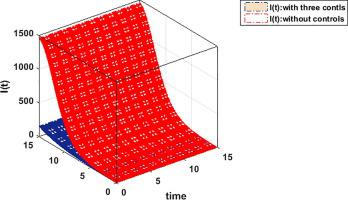Journal of Advanced Research ( IF 10.7 ) Pub Date : 2020-08-25 , DOI: 10.1016/j.jare.2020.08.006 N H Sweilam 1 , S M Al-Mekhlafi 2 , D Baleanu 3, 4

|
Introduction
Coronavirus COVID-19 pandemic is the defining global health crisis of our time and the greatest challenge we have faced since world war two. To describe this disease mathematically, we noted that COVID-19, due to uncertainties associated to the pandemic, ordinal derivatives and their associated integral operators show deficient. The fractional order differential equations models seem more consistent with this disease than the integer order models. This is due to the fact that fractional derivatives and integrals enable the description of the memory and hereditary properties inherent in various materials and processes. Hence there is a growing need to study and use the fractional order differential equations. Also, optimal control theory is very important topic to control the variables in mathematical models of infectious disease. Moreover, a hybrid fractional operator which may be expressed as a linear combination of the Caputo fractional derivative and the Riemann–Liouville fractional integral is recently introduced. This new operator is more general than the operator of Caputo’s fractional derivative. Numerical techniques are very important tool in this area of research because most fractional order problems do not have exact analytic solutions.
Objectives
A novel fractional order Coronavirus (2019-nCov) mathematical model with modified parameters will be presented. Optimal control of the suggested model is the main objective of this work. Three control variables are presented in this model to minimize the number of infected populations. Necessary control conditions will be derived.
Methods
The numerical methods used to study the fractional optimality system are the weighted average nonstandard finite difference method and the Grünwald-Letnikov nonstandard finite difference method.
Results
The proposed model with a new fractional operator is presented. We have successfully applied a kind of Pontryagin’s maximum principle and were able to reduce the number of infected people using the proposed numerical methods. The weighted average nonstandard finite difference method with the new operator derivative has the best results than Grünwald-Letnikov nonstandard finite difference method with the same operator. Moreover, the proposed methods with the new operator have the best results than the proposed methods with Caputo operator.
Conclusions
The combination of fractional order derivative and optimal control in the Coronavirus (2019-nCov) mathematical model improves the dynamics of the model. The new operator is more general and suitable to study the optimal control of the proposed model than the Caputo operator and could be more useful for the researchers and scientists.
中文翻译:

一种新型冠状病毒(2019-nCov)数学模型的混合分数最优控制
介绍
冠状病毒 COVID-19 大流行是我们这个时代决定性的全球健康危机,也是我们自第二次世界大战以来面临的最大挑战。为了从数学上描述这种疾病,我们注意到 COVID-19,由于与大流行相关的不确定性,序数导数及其相关的积分算子显示出缺陷。分数阶微分方程模型似乎比整数阶模型更符合这种疾病。这是因为分数导数和积分能够描述各种材料和过程中固有的记忆和遗传特性。因此,越来越需要研究和使用分数阶微分方程。此外,最优控制理论是控制传染病数学模型中变量的重要课题。而且,最近引入了一种混合分数算子,它可以表示为 Caputo 分数阶导数和 Riemann-Liouville 分数阶积分的线性组合。这个新算子比 Caputo 分数阶导数的算子更通用。数值技术是该研究领域中非常重要的工具,因为大多数分数阶问题没有精确的解析解。
目标
将介绍一种具有修改参数的新型分数阶冠状病毒 (2019-nCov) 数学模型。建议模型的最佳控制是这项工作的主要目标。该模型中提供了三个控制变量,以最大限度地减少受感染人群的数量。将导出必要的控制条件。
方法
用于研究分数最优系统的数值方法是加权平均非标准有限差分法和 Grünwald-Letnikov 非标准有限差分法。
结果
提出了具有新分数运算符的模型。我们已经成功地应用了一种庞特里亚金最大值原理,并且能够使用所提出的数值方法减少感染人数。使用新算子导数的加权平均非标准有限差分法比具有相同算子的Grünwald-Letnikov非标准有限差分法效果最好。此外,与使用Caputo算子的建议方法相比,使用新算子的建议方法具有最好的结果。
结论
冠状病毒(2019-nCov)数学模型中分数阶导数和最优控制的结合提高了模型的动态性。新算子比 Caputo 算子更通用,更适合研究所提出模型的最优控制,对研究人员和科学家更有用。



























 京公网安备 11010802027423号
京公网安备 11010802027423号